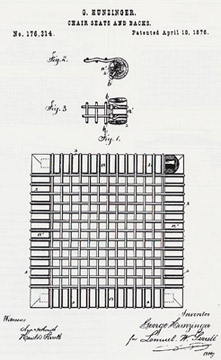Product Description
George Jakob Hunzinger New York 19th Century Rare Painted Chair 1876


GEORGE JAKOB HUNZINGER (1835-1898) Germany/ USA
Chair 1876
Yellow and blue painted elaborately turned wood, blue thread woven covered metal band mesh seat (original condition)
Marks: George Hunzinger Patent 1876
Illustrated: The Furniture of George Hunzinger, Invention and Innovation in Nineteenth-Century America, Barry R. Harwood (Brooklyn: Brooklyn Museum of Art, 1997) p.103.
H: 32″ x D: 17″ x W: 20″
GEORGE JAKOB HUNZINGER (1835-18989) USA
George Hunzinger emigrated in the 1850s from the Black Forest region of Germany where his family had worked as cabinetmakers since the 17th century. Settling in New York, he joined a community of 3,000 German furniture makers but soon distinguished himself as a maker of patent furniture and “fancy chairs”. Hunzinger’s innovative designs are often associated with the development of the Aesthetic Movement in America. By the 1870s, his chairs were sought after by many Americans as accent pieces for their parlors. The woven mesh or upholstery of these innovative chairs follows the original intention of the maker and the turned frame has an avant-garde, colorful and rather contemporary feeling painted in a combination of a rich ochre yellow and cobalt blue, a color combo that was highly prized for it’s eccentricity in Victorian America.
George Jakob Hunzinger New York 19th Century Rare Painted Chair 1876
Cartier Art Deco brooch, carved rock crystal with a fancy platinum mount set with two European and cushion cut diamonds (approx. 3 carats TW) further set with two European and cushion cut diamonds (approx. 1 carat TW) with diamond pave work filling out the surrounding floral motif, original leather box, signed and numbered, c. 1925
